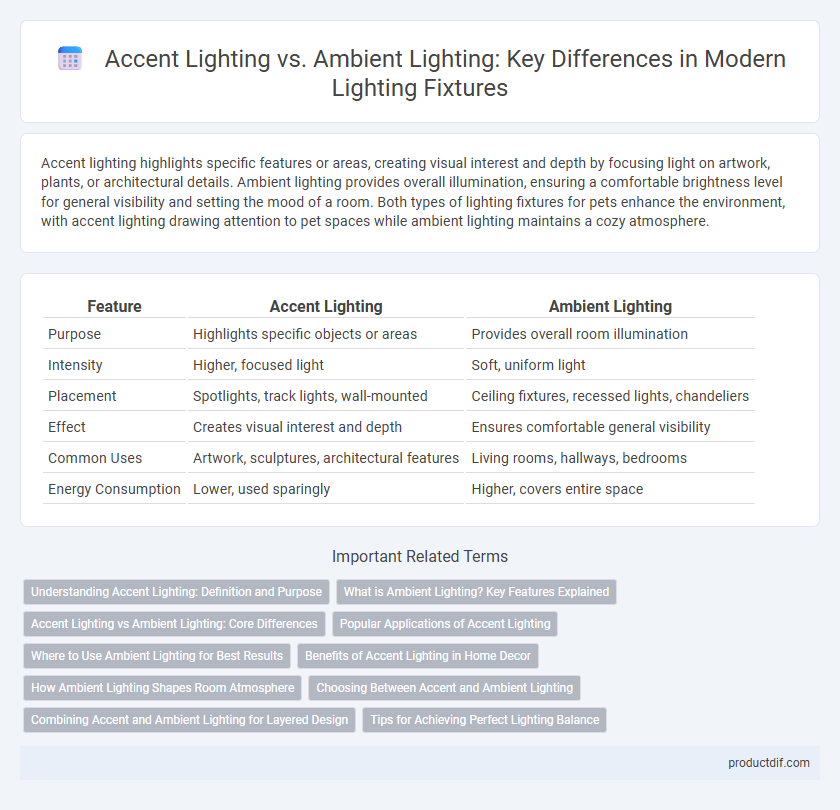Accent lighting highlights specific features or areas, creating visual interest and depth by focusing light on artwork, plants, or architectural details. Ambient lighting provides overall illumination, ensuring a comfortable brightness level for general visibility and setting the mood of a room. Both types of lighting fixtures for pets enhance the environment, with accent lighting drawing attention to pet spaces while ambient lighting maintains a cozy atmosphere.
Table of Comparison
| Feature | Accent Lighting | Ambient Lighting |
|---|---|---|
| Purpose | Highlights specific objects or areas | Provides overall room illumination |
| Intensity | Higher, focused light | Soft, uniform light |
| Placement | Spotlights, track lights, wall-mounted | Ceiling fixtures, recessed lights, chandeliers |
| Effect | Creates visual interest and depth | Ensures comfortable general visibility |
| Common Uses | Artwork, sculptures, architectural features | Living rooms, hallways, bedrooms |
| Energy Consumption | Lower, used sparingly | Higher, covers entire space |
Understanding Accent Lighting: Definition and Purpose
Accent lighting is designed to highlight specific objects or architectural features, creating visual interest and depth within a space. It uses focused beam angles and higher intensity compared to ambient lighting to draw attention and enhance textures, colors, and shapes. This type of lighting improves overall aesthetics by adding contrast and dimension without providing uniform illumination.
What is Ambient Lighting? Key Features Explained
Ambient lighting provides general, uniform illumination that ensures overall visibility and comfort in a space, typically achieved through ceiling fixtures, wall sconces, or recessed lights. Its key features include soft, diffused light that minimizes shadows and glare, creating a welcoming atmosphere and enhancing the room's functionality. Unlike accent lighting, ambient lighting serves as the foundational layer of a lighting design, supporting all other types of illumination.
Accent Lighting vs Ambient Lighting: Core Differences
Accent lighting highlights specific objects or areas, creating visual interest and enhancing focal points within a room, while ambient lighting provides uniform illumination for overall visibility and comfort. Accent lighting typically uses directional fixtures such as spotlights or track lights to draw attention, contrasting with ambient lighting's use of ceiling-mounted or wall-mounted fixtures that diffuse light evenly. Understanding these core differences helps in designing layered lighting schemes that balance functionality with aesthetics.
Popular Applications of Accent Lighting
Accent lighting highlights architectural features, artwork, and decorative objects to create visual interest and depth in residential and commercial spaces. Popular applications include wall sconces, track lighting, and recessed spotlights used in galleries, retail stores, and living rooms to draw attention to specific areas or items. This lighting technique enhances ambiance by providing focused illumination that contrasts with ambient lighting's overall brightness.
Where to Use Ambient Lighting for Best Results
Ambient lighting is essential for general illumination in living rooms, kitchens, and bedrooms, creating a comfortable and evenly lit environment. It works best when installed as ceiling-mounted fixtures, recessed lights, or wall sconces that distribute light uniformly across the space. Using dimmable ambient lighting allows for adjustable brightness to suit different activities and moods, enhancing the overall functionality of the room.
Benefits of Accent Lighting in Home Decor
Accent lighting enhances home decor by highlighting architectural features, artwork, and textures, creating visual interest and depth in a room. It adds dimension and contrast, making spaces feel more dynamic and inviting while allowing homeowners to showcase focal points effectively. Compared to ambient lighting, accent lighting offers targeted illumination that elevates the overall aesthetic and mood without overwhelming the space.
How Ambient Lighting Shapes Room Atmosphere
Ambient lighting provides a uniform level of illumination that establishes the overall mood and atmosphere of a room by softly diffusing light to eliminate harsh shadows. Unlike accent lighting that highlights specific features, ambient lighting ensures visual comfort and creates a welcoming environment suitable for daily activities. Effective use of ambient lighting fixtures, such as ceiling-mounted LED panels or recessed lights, enhances space perception and promotes relaxation through balanced light distribution.
Choosing Between Accent and Ambient Lighting
Choosing between accent and ambient lighting depends on the desired mood and functional requirements of a space. Accent lighting highlights specific objects or architectural features, creating visual interest and depth, while ambient lighting provides uniform illumination that ensures overall visibility and comfort. Selecting the right balance enhances interior design by combining practicality with aesthetic appeal.
Combining Accent and Ambient Lighting for Layered Design
Combining accent lighting with ambient lighting creates a layered design that enhances depth and dimension in any space. Accent lighting highlights focal points such as artwork or architectural features, while ambient lighting provides overall illumination for comfort and functionality. This integration balances visual interest and practical brightness, resulting in a harmonious and versatile lighting scheme.
Tips for Achieving Perfect Lighting Balance
Accent lighting highlights specific features like artwork or architectural details by creating focal points with directional light, while ambient lighting provides overall illumination for a room's functionality. To achieve the perfect lighting balance, use dimmers to adjust ambient light levels and layer accent lights at varying intensities and angles to avoid harsh shadows or overly bright spots. Incorporate warm color temperatures and strategically placed fixtures to harmonize both lighting types, enhancing the space's mood and depth without overpowering.
Accent lighting vs Ambient lighting Infographic

 productdif.com
productdif.com